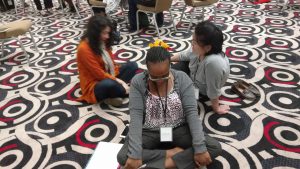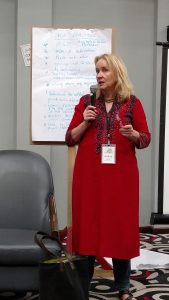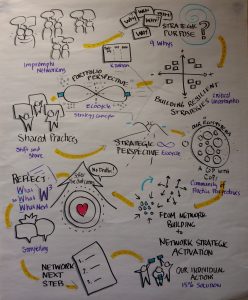 In late January I helped plan and facilitate the INGENEAS Global Symposium, a gathering of academics, researchers, practitioners, business people and policy makers interested in the role of gender and nutrition in rural agricultural extension services in the developing world. We used Liberating Structures extensively throughout the 3 day event.
In late January I helped plan and facilitate the INGENEAS Global Symposium, a gathering of academics, researchers, practitioners, business people and policy makers interested in the role of gender and nutrition in rural agricultural extension services in the developing world. We used Liberating Structures extensively throughout the 3 day event.
Have you ever had the experience in a global meeting where jet lag is an ongoing presence, prompting naps and drooping heads? We saw no napping! People were engaged, occasionally baffled, and exceptionally open to new ways of being together, even those who are most comfortable in traditional academic meetings. The only persistent wish was for more time to “go deeper” in exploring and learning about each other’s work. We hope people will stay connected and build that depth. (More on that in a later blog post about the network mapping project we also did!)
 It was fabulous to have a client, Andrea Bohn, who fully embraced both my crazy approaches and Liberating Structures. Her support was so thorough that we used LS to plan the meetings as well. After the meeting she connected participants who expressed interest in Liberating Structures to their local (or nearly local) practice group for further learning, practice/peer support, and sent out this follow up email:
It was fabulous to have a client, Andrea Bohn, who fully embraced both my crazy approaches and Liberating Structures. Her support was so thorough that we used LS to plan the meetings as well. After the meeting she connected participants who expressed interest in Liberating Structures to their local (or nearly local) practice group for further learning, practice/peer support, and sent out this follow up email:
Dear Symposium participants,
Hard to believe that it has already been more than a week since we parted in Lusaka. It was great to have you there!
One of the follow-up actions I committed to is to tell you a bit more about the facilitation techniques used by Nancy.
It was one of our unspoken intentions with the symposium was to expose you to some very effective means of engaging and including all people (in an organization, at a meeting, training, etc.) and for helping bring to light the knowledge and experiences that exists among those gathered. We trust that you will find these techniques useful in your work as extensionists, trainers, team leads, etc. Most of the techniques used (some in modified form) come from the “Liberating Structures” toolbox (see www.liberatingstructures.com). Over the course of the symposium you experienced (and participated in!) these:
Day 1
- Impromptu networking www.liberatingstructures.com/2-impromptu-networking (e.g., to build relationships and shared expectations)
- Storytelling Keynote/Celebrity Interview: www.liberatingstructures.com/22-celebrity-interview
- World Café / Conversation Café www.liberatingstructures.com/17-conversation-cafe
- Shift & Share www.liberatingstructures.com/11-shift-share%20
- Share Fair – this is not part of the Liberating Structures tool box (NW note: it is a lot like Shift and Share… ;-))
Day 2
- Human Spectrogram (e.g., to get a sense of people’s thinking and experience so far about the gathering and the issues) – this is not part of the Liberating Structures tool box (NW note: AND it is used as “punctuation” between LS’s by many practitioners)
- TRIZ www.liberatingstructures.com/6-making-space-with-triz (for those who attended the Capacity Building huddle)
- Wicked Questions www.liberatingstructures.com/4-wicked-questions%20 (for those who attended the Teaching and Training huddle)
- Open Space/Market Place www.liberatingstructures.com/25-open-space-technology
Day 3
- 25/10 Crowdsourcing www.liberatingstructures.com/12-2510-crowd-sourcing – Stimulate your imagination before planning
- 15% Solution www.liberatingstructures.com/7-15-solutions
- Purpose to Practice www.liberatingstructures.com/33-purpose-to-practice-p2p
- Troika Consulting www.liberatingstructures.com/8-troika-consulting%20
In planning the symposium, we were guided by
- What, So What, Now What www.liberatingstructures.com/9-what-so-what-now-what-w to set objectives, and we used
- Purpose to Practice www.liberatingstructures.com/33-purpose-to-practice-p2p throughout the preparation phase
There are many more structures/techniques in that toolbox (33 in total, www.liberatingstructures.com/ls-menu). The website describes each in some detail and we encourage you to explore them. However, we also know that it all makes a lot more sense after you have experienced one in action, as you did during the Symposium. I’d love to hear from you how using one or several of these structures in your profession is working out for you.
Sincerely,
Andrea
Andrea Bohn, M.Sc., MBA
Member of the AgReach Team
I’ve been either sending a follow up email, or creating an information visual about LS in meetings I am facilitating with LS because it is a simple capacity building step that is both efficient and effective. People are interested in the moment, and the follow up email is a perfect trigger point to invite them to dig in a little deeper. Here is the summary visual I created for a group last December after one of the participants made the request for the “list” of structures. Why not make it visual?
Debriefing With the Team
Beyond participant interest in Liberating Structures, I’ve found it very useful to debrief with the core event planning and facilitation team to get a sense of their experiences and to encourage further application.
In a more traditional academic conference context, this is always interesting. We tend to gravitate towards that which is familiar and comfortable. Those who have literally grown up and experienced their entire careers through formal academic gatherings may feel a bit like “fish out of water” with LS. Through the debrief at this event and others, three main issues come out.
- Control is distributed, not held at the front of the room. For example, in traditional academic conferences people present their papers from the front of the room and then the audience asks questions. With Shift and Share, a greater part of the time was focused on the conversation, rather than presentation. Repeating cycles start to drill down to the most salient issues and points, but that is not always obvious from the start! For those who are used to holding control via presentation and who they choose to call on, this is a power shift as well.
- Time feels “too short.” Many of the LS cycle participants rapidly through the work and/or content at hand, and look at it from different perspectives via different structures. There is an instinct to “slow down” but sometimes the rapid cycling can help step past ruts and assumptions allowing greater depth. Over-packing a conference, however, with too much content, can stymie that result. And somehow we always over-pack!
- It steps outside of “sanctioned forms.” “I can go to the meeting if I am presenting a paper.” The way legitimacy is viewed in research communities is based on publishing. On presenting. With LS, we focus on meaning making on what is offered, versus exposition. So we need a way to create an invitation that has institutional legitimacy for those coming, but which does not box us into traditional forms if they don’t serve the purpose of the meeting. Across the LS community of practitioners there is deep experience with significant meeting results — without panels and presentations. But it is a leap of faith to go down that road!

How do you overpack and remain minimalist?! A particularly gnarly design paradox for me at the moment. Maybe I need to take each design and ruthlessly Min Spec it: If we eliminated this LS could we still achieve the purpose? But then you have to leave favored children behind…
This would be a great experiment, Fisher, the min spec-ing of the design. And how to min spec both content AND process! The criteria may vary wildly amongst the planning team!
My second question for the design team: If we only get through 20% of this will you still be satisfied?!
Depends on the purpose, eh?
If you can achieve your purpose in one day you’re not being bold enough! 8^)
My latest disclaimer: It is highly likely that we will end in a state of dynamic incompleteness…
Fisher, this is why we all love you!
Dear Nancy
I love you and what you do in the world and then share.
I wish I could be you. There’s a longing in me to be in the world in this way and in a world that likes to be this way.
Liberating structures is wonderful and messy 🙂
much love
Jen
I’m smiling